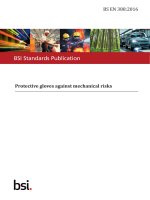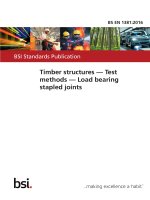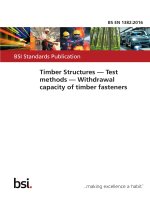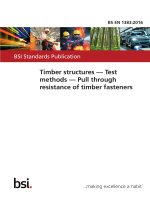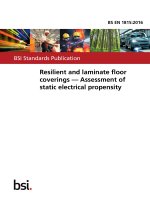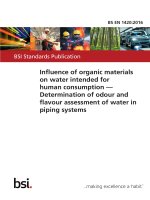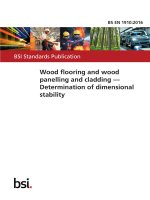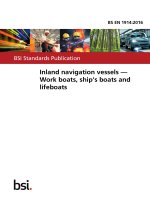Bsi bs en 62424 2016
Bạn đang xem bản rút gọn của tài liệu. Xem và tải ngay bản đầy đủ của tài liệu tại đây (9.12 MB, 172 trang )
BS EN 62424:2016
BSI Standards Publication
Representation of process
control engineering — Requests
in P&I diagrams and data
exchange between P&ID
tools and PCE-CAE tools
BRITISH STANDARD
BS EN 62424:2016
National foreword
This British Standard is the UK implementation of EN 62424:2016. It is
identical to IEC 62424:2016. It supersedes BS EN 62424:2009, which will be
withdrawn on 19 August 2019.
The UK participation in its preparation was entrusted to Technical
Committee GEL/65, Measurement and control.
A list of organizations represented on this committee can be obtained on
request to its secretary.
This publication does not purport to include all the necessary provisions of
a contract. Users are responsible for its correct application.
© The British Standards Institution 2017.
Published by BSI Standards Limited 2017
ISBN 978 0 580 82343 5
ICS 25.040.40; 35.240.50
Compliance with a British Standard cannot confer immunity from
legal obligations.
This British Standard was published under the authority of the
Standards Policy and Strategy Committee on 31 January 2017.
Amendments/corrigenda issued since publication
Date
Text affected
BS EN 62424:2016
EN 62424
EUROPEAN STANDARD
NORME EUROPÉENNE
EUROPÄISCHE NORM
November 2016
ICS 25.040.40; 35.240.50
Supersedes EN 62424:2009
English Version
Representation of process control engineering Requests in P&I diagrams and data exchange
between P&ID tools and PCE-CAE tools
(IEC 62424:2016)
Représentation de l'ingénierie de commande de processus Demandes sous forme de diagrammes P&I et échange de
données entre outils P&ID et outils PCE-CAE
(IEC 62424:2016)
Darstellung von Aufgaben der Prozessleittechnik Fließbilder und Datenaustausch zwischen EDV-Werkzeugen
zur Fließbilderstellung und CAE-Systemen
(IEC 62424:2016)
This European Standard was approved by CENELEC on 2016-08-19. CENELEC members are bound to comply with the CEN/CENELEC
Internal Regulations which stipulate the conditions for giving this European Standard the status of a national standard without any alteration.
Up-to-date lists and bibliographical references concerning such national standards may be obtained on application to the CEN-CENELEC
Management Centre or to any CENELEC member.
This European Standard exists in three official versions (English, French, German). A version in any other language made by translation
under the responsibility of a CENELEC member into its own language and notified to the CEN-CENELEC Management Centre has the
same status as the official versions.
CENELEC members are the national electrotechnical committees of Austria, Belgium, Bulgaria, Croatia, Cyprus, the Czech Republic,
Denmark, Estonia, Finland, Former Yugoslav Republic of Macedonia, France, Germany, Greece, Hungary, Iceland, Ireland, Italy, Latvia,
Lithuania, Luxembourg, Malta, the Netherlands, Norway, Poland, Portugal, Romania, Slovakia, Slovenia, Spain, Sweden, Switzerland,
Turkey and the United Kingdom.
European Committee for Electrotechnical Standardization
Comité Européen de Normalisation Electrotechnique
Europäisches Komitee für Elektrotechnische Normung
CEN-CENELEC Management Centre: Avenue Marnix 17, B-1000 Brussels
© 2016 CENELEC All rights of exploitation in any form and by any means reserved worldwide for CENELEC Members.
Ref. No. EN 62424:2016 E
BS EN 62424:2016
EN 62424:2016
European foreword
The text of document 65/544/CDV, future edition 2 of IEC 62424, prepared by IEC/TC 65 "Industrialprocess measurement, control and automation" was submitted to the IEC-CENELEC parallel vote and
approved by CENELEC as EN 62424:2016.
The following dates are fixed:
•
latest date by which the document has to be implemented at
national level by publication of an identical national
standard or by endorsement
(dop)
2017-05-19
•
latest date by which the national standards conflicting with
the document have to be withdrawn
(dow)
2019-08-19
This document supersedes EN 62424:2009.
Attention is drawn to the possibility that some of the elements of this document may be the subject of
patent rights. CENELEC [and/or CEN] shall not be held responsible for identifying any or all such
patent rights.
Endorsement notice
The text of the International Standard IEC 62424:2016 was approved by CENELEC as a European
Standard without any modification.
In the official version, for Bibliography, the following notes have to be added for the standards indicated:
2
IEC 60848
NOTE
Harmonized as EN 60848.
IEC 61512-1
NOTE
Harmonized as EN 61512-1.
IEC 61987-1
NOTE
Harmonized as EN 61987-1.
ISO 10628-1
NOTE
Harmonized as EN ISO 10628-1.
ISO 10628-2
NOTE
Harmonized as EN ISO 10628-2.
ISO 13628-6
NOTE
Harmonized as EN ISO 13628-6.
ISO 13703
NOTE
Harmonized as EN ISO 13703.
BS EN 62424:2016
EN 62424:2016
Annex ZA
(normative)
Normative references to international publications
with their corresponding European publications
The following documents, in whole or in part, are normatively referenced in this document and are
indispensable for its application. For dated references, only the edition cited applies. For undated
references, the latest edition of the referenced document (including any amendments) applies.
NOTE 1
When an International Publication has been modified by common modifications, indicated by (mod),
the relevant EN/HD applies.
NOTE 2
Up-to-date information on the latest versions of the European Standards listed in this annex is
available here: www.cenelec.eu.
Publication
Year
Title
EN/HD
Year
IEC 61511-1
-
Functional safety - Safety instrumented
systems for the process industry sector Part 1: Framework, definitions, system,
hardware and application programming
requirements
EN 61511-1
-
IEC 81346-1
2009
Industrial systems, installations and
equipment and industrial products Structuring principles and reference
designations Part 1: Basic rules
EN 81346-1
2009
ISO 13849-1
-
Safety of machinery - Safety-related
parts of control systems Part 1: General principles for design
EN ISO 13849-1
-
W3C XML 1.0
2004
Extensible Markup Language (XML) 1.0
-
-
3
BS EN 62424:2016
–2–
IEC 62424:2016 IEC 2016
CONTENTS
FOREWORD ......................................................................................................................... 8
INTRODUCTION ................................................................................................................. 10
1
Scope .......................................................................................................................... 12
2
Normative references................................................................................................... 12
3
Terms and definitions .................................................................................................. 12
4
Abbreviations .............................................................................................................. 17
5
Conformity ................................................................................................................... 18
6
Representation of PCE requests in a P&ID ................................................................... 19
6.1
6.2
6.3
7
PCE request and PCE loop ................................................................................. 19
Objectives and principles ..................................................................................... 20
Requirements for the reference designation and representation of PCE
requests .............................................................................................................. 20
6.3.1
General ....................................................................................................... 20
6.3.2
Types of lines .............................................................................................. 21
6.3.3
Displaying the location of the operator interface ............................................ 21
6.3.4
PCE categories and processing functions ..................................................... 22
6.3.5
PCE request reference designation system ................................................... 25
6.3.6
PU-vendor and typical identification .............................................................. 26
6.3.7
Device information ....................................................................................... 26
6.3.8
Alarming, switching and indicating ................................................................ 27
6.3.9
Safety-relevant, GMP and quality-relevant PCE requests .............................. 27
6.3.10
PCE control functions ................................................................................... 28
Neutral data exchange of PCE relevant P&ID information ............................................. 29
7.1
7.2
7.3
7.4
7.4.1
7.4.2
7.5
8
Objectives ........................................................................................................... 29
Meaning of P&ID elements .................................................................................. 29
PCE relevant information of P&ID tools ................................................................ 30
Formal description of PCE relevant information of P&ID tools ............................... 31
General object model of a plant hierarchy ..................................................... 31
General object model of a PCE request ........................................................ 31
Modeling PCE relevant information using the CAEX system description
language ............................................................................................................. 32
7.5.1
Overview ..................................................................................................... 32
7.5.2
Basic CAEX mappings ................................................................................. 33
7.5.3
Standard CAEX library of PCE request related attributes .............................. 34
7.5.4
Mapping of indirect links between PCE requests of different plant
sections ....................................................................................................... 35
7.5.5
CAEX description of direct links between PCE requests of different
plant sections............................................................................................... 38
7.5.6
PCE loops.................................................................................................... 40
Additional PCE attributes ............................................................................................. 40
Annex A (normative) CAEX – Data model for machine information exchange ...................... 42
A.1
CAEX and its diagram conventions ...................................................................... 42
A.2
General CAEX concepts ...................................................................................... 43
A.2.1
General CAEX terms .................................................................................... 43
A.2.2
General CAEX concept description ............................................................... 46
A.2.3
Data definition of SystemUnitClass ............................................................... 50
BS EN 62424:2016
IEC 62424:2016 IEC 2016
–3–
A.2.4
Definition of attributes .................................................................................. 52
A.2.5
Data definition of an AttributeType ................................................................ 54
A.2.6
Data definition of InterfaceClass ................................................................... 56
A.2.7
Data definition of RoleClass ......................................................................... 59
A.2.8
Modelling of relations ................................................................................... 60
A.2.9
Usage of paths ............................................................................................. 68
A.2.10
CAEX role concept ....................................................................................... 69
A.2.11
Use of the CAEX MappingObject .................................................................. 74
A.2.12
References to external CAEX files ................................................................ 76
A.3
CAEX schema definition ...................................................................................... 78
A.3.1
General ....................................................................................................... 78
A.3.2
Element CAEXFile ....................................................................................... 79
A.3.3
CAEXFile/SuperiorStandardVersion .............................................................. 81
A.3.4
CAEXFile/ SourceDocumentInformation ........................................................ 81
A.3.5
CAEXFile/ExternalReference ........................................................................ 82
A.3.6
CAEXFile/InstanceHierarchy ........................................................................ 83
A.3.7
CAEXFile/InstanceHierarchy/InternalElement ............................................... 84
A.3.8
CAEXFile/InterfaceClassLib ......................................................................... 85
A.3.9
CAEXFile/InterfaceClass .............................................................................. 86
A.3.10
CAEXFile/RoleClassLib ................................................................................ 87
A.3.11
CAEXFile/RoleClass .................................................................................... 88
A.3.12
CAEXFile/SystemUnitClassLib ..................................................................... 89
A.3.13
CAEXFile/SystemUnitClass .......................................................................... 90
A.3.14
CAEXFile/AttributeTypeLib ........................................................................... 91
A.3.15
Group Header .............................................................................................. 93
A.3.16
CAEX complex type AttributeFamilyType ...................................................... 98
A.3.17
CAEX complex type AttributeFamilyType/AttributeType ................................. 99
A.3.18
CAEX complex type AttributeType .............................................................. 100
A.3.19
CAEX complex type CAEXBasicObject ....................................................... 108
A.3.20
CAEX complex type CAEXObject ............................................................... 109
A.3.21
CAEX complex type InterfaceClassType ..................................................... 110
A.3.22
CAEX complex type InterfaceFamilyType.................................................... 113
A.3.23
CAEX complex type InternalElementType ................................................... 115
A.3.24
CAEX complex type RoleClassType ........................................................... 123
A.3.25
CAEX complex type RoleFamilyType .......................................................... 125
A.3.26
CAEX complexType SourceDocumentInformationType ................................ 128
A.3.27
CAEX complex type SystemUnitClassType ................................................. 129
A.3.28
CAEX complex type SystemUnitFamilyType ................................................ 136
A.3.29
CAEX simpleType ChangeMode ................................................................. 138
Annex B (informative) Examples of PCE requests ............................................................. 139
Annex C (normative) Full XML schema of the CAEX model ............................................... 149
Annex D (informative) CAEX modelling examples ............................................................. 155
D.1
D.2
D.3
D.4
Annex E
CAEX Attribute Type Library definition for additional attributes ........................... 155
Example of CAEX InterfaceLib definition ............................................................ 156
Example of a CAEX RoleLib definition ............................................................... 157
Example CAEX definition of PCE relevant P&ID information ............................... 158
(informative) List of major changes and extensions of the second edition ............ 163
Bibliography ..................................................................................................................... 166
BS EN 62424:2016
–4–
IEC 62424:2016 IEC 2016
Figure 1 – Information flow between P&ID and PCE tool ...................................................... 11
Figure 2 – Organization of PCE requests ............................................................................. 20
Figure 3 – General representation of a PCE-Request in a P&ID ........................................... 21
Figure 4 – Multi-sensing element ......................................................................................... 21
Figure 5 – Local interface ................................................................................................... 22
Figure 6 – Manually operated switch in local control panel ................................................... 22
Figure 7 – Pressure indication in central control room by a central control system ................ 22
Figure 8 – Example of PCE request reference designation ................................................... 26
Figure 9 – Example of flow measurement with indication in the CCR delivered by
vendor A specified by typical identification A20.................................................................... 26
Figure 10 – Example of pH-measurement with indication in the CCR .................................... 26
Figure 11 – Example of flow measurement with indication in the CCR and high and
low alarm ............................................................................................................................ 27
Figure 12 – Flow measurement with indication in the CCR and high alarm and a highhigh switching function ........................................................................................................ 27
Figure 13 – Flow measurement with indication in the CCR and a high-high switch limit,
a high alarm, a low alarm and a low-low switch limit for a safety function ............................. 27
Figure 14 – GMP relevant, safety relevant and quality relevant flow measurement with
indication in the CCR .......................................................................................................... 28
Figure 15 – Control function ................................................................................................ 28
Figure 16 – Safety relevant control function ......................................................................... 29
Figure 17 – P&ID elements and associations (PCE relevant items are shown in dark
lines) .................................................................................................................................. 30
Figure 18 – Process data model (PCE relevant items are shown in dark lines) ..................... 31
Figure 19 – PCE request data model ................................................................................... 32
Figure 20 – CAEX data model of major PCE request related attributes ................................. 35
Figure 21 – XML code of the attribute type library ................................................................ 35
Figure 22 – Example of two plant sections and a signal connection via external
interfaces ........................................................................................................................... 36
Figure 23 – Simplified CAEX model of indirect links between PCE requests across
different plant hierarchy items ............................................................................................. 37
Figure 24 – Simplified CAEX model of indirect links between PCE requests across
different plant hierarchy items ............................................................................................. 38
Figure 25 – Example of two plant sections and a direct connection ...................................... 39
Figure 26 – Simplified CAEX model of direct links between PCE requests across
different sections of a plant ................................................................................................. 39
Figure 27 – XML code of the simplified CAEX model ............................................................ 40
Figure A.1 – XML text of the CAEX source document information ......................................... 49
Figure A.2 – CAEX architecture of a SystemUnitClass ......................................................... 51
Figure A.3 – Example of a SystemUnitClassLib ................................................................... 51
Figure A.4 – XML code of the example of a SystemUnitClassLib .......................................... 52
Figure A.5 – Examples of attributes ..................................................................................... 53
Figure A.6 – XML code of the example ................................................................................ 54
Figure A.7 – Example of an AttributeTypeLib and its application in an instance
hierarchy ............................................................................................................................ 55
BS EN 62424:2016
IEC 62424:2016 IEC 2016
–5–
Figure A.8 – XML code of the AttributeTypeLib example ...................................................... 55
Figure A.9 – Example of an InterfaceClassLib ..................................................................... 56
Figure A.10 – XML code of the example of an InterfaceClassLib .......................................... 57
Figure A.11 – Second example of an InterfaceClassLib and the usage of nested
interfaces ........................................................................................................................... 57
Figure A.12 – XML code of the second example .................................................................. 58
Figure A.13 – Usage of Links .............................................................................................. 59
Figure A.14 – XML code for the usage of links ..................................................................... 59
Figure A.15 – Example of a RoleClassLib ............................................................................ 60
Figure A.16 – Relations in CAEX ......................................................................................... 61
Figure A.17 – XML description of the relations example ....................................................... 62
Figure A.18 – XML text of the InstanceHierarchy of the relations example ............................ 62
Figure A.19 – XML text of the SystemUnitClassLib of the relations example ......................... 62
Figure A.20 – Example of a parent-child-relation between CAEX InternalElements ............... 63
Figure A.21 – Example for a hierarchical plant structure ...................................................... 63
Figure A.22 – Example of a parent-child relation between classes ....................................... 64
Figure A.23 – Multiple crossed structures ............................................................................ 67
Figure A.24 – Example for mirror attributes and restructured mirror objects .......................... 67
Figure A.25 – CAEX role concept ........................................................................................ 70
Figure A.26 – CAEX data definition for use case 1 ............................................................... 70
Figure A.27 – CAEX data definition for use case 2 ............................................................... 71
Figure A.28 – CAEX data definition for use case 3 ............................................................... 71
Figure A.29 – XML code for use case 3 ............................................................................... 72
Figure A.30 – Multiple role support ...................................................................................... 73
Figure A.31 – XML code of the multiple role support example .............................................. 74
Figure A.32 – CAEX data definition of a MappingObject ....................................................... 75
Figure A.33 – XML code for the data definition of a MappingObject ...................................... 76
Figure A.34 – Distribution of data in several CAEX files ....................................................... 77
Figure A.35 – Referencing of external CAEX files ................................................................ 77
Figure A.36 – XML code for referencing of external CAEX files ............................................ 77
Figure A.37 – Example of how to use alias names ............................................................... 78
Figure A.38 – XML code for the alias example ..................................................................... 78
Figure B.1 – Local level indication, 1 process connection ................................................... 139
Figure B.2 – Local level indication, 2 process connections ................................................. 139
Figure B.3 – Local flow indication ...................................................................................... 139
Figure B.4 – Local pressure indication ............................................................................... 139
Figure B.5 – Local temperature indication .......................................................................... 139
Figure B.6 – Local control panel, pressure indication, high alarm ....................................... 140
Figure B.7 – Local temperature indication, CCR temperature high alarm ............................ 140
Figure B.8 – Local pressure indication, CCR pressure high alarm and switch ..................... 140
Figure B.9 – CCR flow indication, device information: Orifice Plate .................................... 140
Figure B.10 – CCR pressure indication, low, low low and high alarm .................................. 140
Figure B.11 – CCR temperature indication and registration ................................................ 141
BS EN 62424:2016
–6–
IEC 62424:2016 IEC 2016
Figure B.12 – CCR level indication and registration, 1 process connection ......................... 141
Figure B.13 – CCR level indication, 2 process connections ................................................ 141
Figure B.14 – Two flow indications and flow ratio control in CCR ....................................... 141
Figure B.15 – CCR flow indication and high alarm, flow control, control valve with extra
interlock and open/close indication .................................................................................... 142
Figure B.16 – Local pressure indication, CCR pressure indication, high alarm and high
high safety relevant switch; representation of transmitters with integrated local display
(if not otherwise defined in a specification of the field device) ............................................ 142
Figure B.17 – Local pressure indication, CCR pressure indication, alarms and switches ..... 142
Figure B.18 – CCR pressure indication, high and low alarm, safety relevant switch
action on on/off valve ........................................................................................................ 143
Figure B.19 – Switched valve with on/off indication and switching action, safety
relevant switched valve ..................................................................................................... 143
Figure B.20 – Pressure restriction ..................................................................................... 143
Figure B.21 – Flow restriction ............................................................................................ 143
Figure B.22 – PT compensated flow control, safety-relevant pressure switch (two out of
three (2oo3) shutdown), switched control valve with on/off indication and switching
action at open position ...................................................................................................... 144
Figure B.23 – CCR temperature control, additional manual switch actions from CCR
with indication and local control panel ............................................................................... 144
Figure B.24 – Motor typical, local on/off control, CCR off control, current, fault with
alarm and running indication ............................................................................................. 145
Figure B.25 – Multivariable controller ................................................................................ 145
Figure B.26 – On/off valve with position indication ............................................................. 146
Figure B.27 – On/off valve with safety relevant switch and position indication .................... 146
Figure B.28 – Level control with continuous controller ....................................................... 146
Figure B.29 – Level control with on/off switch .................................................................... 146
Figure B.30 – Cascade control for temperature as control input, flow control as followup controller ..................................................................................................................... 147
Figure B.31 – Safety directed high control to a subsequent valve, manual control for
reset function and manual control for manual/automatic switch of the valve, valve with
open/close indication and safety-relevant switch to subsequent valve ................................ 147
Figure B.32 – Flow control in CCR .................................................................................... 147
Figure B.33 – Temperature control with high alarm and high switch ................................... 148
Figure B.34 – Manual control from CCR ............................................................................ 148
Figure B.35 – Flow measurement with display and alarms in CCR, high high switch on
process control function and switch on/off valve ................................................................ 148
Figure B.36 – Local P-/F-/T-/S- control without auxiliary power (stand-alone) ..................... 148
Figure C.1 – Full XML text of the CAEX Schema file “CAEX_ClassModel_V.3.0.xsd” .......... 154
Figure D.1 – Attribute type library with additional PCE request related attributes ................ 155
Figure D.2 – XML code of the Attribute type library ............................................................ 156
Figure D.3 – Example of CAEX interface library ................................................................. 156
Figure D.4 – XML code of the example CAEX interface library ........................................... 156
Figure D.5 – Example CAEX role library illustrating the modeling of a PCE request role
referencing PCE request related attributes ........................................................................ 157
Figure D.6 – XML code for the example CAEX role library ................................................. 158
Figure D.7 – Example P&ID data to be mapped with CAEX ................................................ 159
BS EN 62424:2016
IEC 62424:2016 IEC 2016
–7–
Figure D.8 – CAEX model of the example described in Figure D.7 ..................................... 160
Figure D.9 – XML code of the example described in Figure D.7 ......................................... 162
Table 1 – Abbrevations ....................................................................................................... 17
Table 2 – PCE categories ................................................................................................... 23
Table 3 – PCE processing function ...................................................................................... 24
Table 4 – Sequence combinations ....................................................................................... 25
Table 5 – PCE processing functions for final controlling equipments .................................... 25
Table 6 – P&ID attributes relevant in PCE environment........................................................ 41
Table 7 – Data handling attributes ....................................................................................... 41
Table A.1 – XML notation conventions ................................................................................. 42
Table A.2 – CAEX data types and elements ......................................................................... 43
BS EN 62424:2016
–8–
IEC 62424:2016 IEC 2016
INTERNATIONAL ELECTROTECHNICAL COMMISSION
____________
REPRESENTATION OF PROCESS CONTROL ENGINEERING –
REQUESTS IN P&I DIAGRAMS AND DATA EXCHANGE
BETWEEN P&ID TOOLS AND PCE-CAE TOOLS
FOREWORD
1) The International Electrotechnical Commission (IEC) is a worldwide organization for standardization comprising
all national electrotechnical committees (IEC National Committees). The object of IEC is to promote
international co-operation on all questions concerning standardization in the electrical and electronic fields. To
this end and in addition to other activities, IEC publishes International Standards, Technical Specifications,
Technical Reports, Publicly Available Specifications (PAS) and Guides (hereafter referred to as “IEC
Publication(s)”). Their preparation is entrusted to technical committees; any IEC National Committee interested
in the subject dealt with may participate in this preparatory work. International, governmental and nongovernmental organizations liaising with the IEC also participate in this preparation. IEC collaborates closely
with the International Organization for Standardization (ISO) in accordance with conditions determined by
agreement between the two organizations.
2) The formal decisions or agreements of IEC on technical matters express, as nearly as possible, an international
consensus of opinion on the relevant subjects since each technical committee has representation from all
interested IEC National Committees.
3) IEC Publications have the form of recommendations for international use and are accepted by IEC National
Committees in that sense. While all reasonable efforts are made to ensure that the technical content of IEC
Publications is accurate, IEC cannot be held responsible for the way in which they are used or for any
misinterpretation by any end user.
4) In order to promote international uniformity, IEC National Committees undertake to apply IEC Publications
transparently to the maximum extent possible in their national and regional publications. Any divergence
between any IEC Publication and the corresponding national or regional publication shall be clearly indicated in
the latter.
5) IEC itself does not provide any attestation of conformity. Independent certification bodies provide conformity
assessment services and, in some areas, access to IEC marks of conformity. IEC is not responsible for any
services carried out by independent certification bodies.
6) All users should ensure that they have the latest edition of this publication.
7) No liability shall attach to IEC or its directors, employees, servants or agents including individual experts and
members of its technical committees and IEC National Committees for any personal injury, property damage or
other damage of any nature whatsoever, whether direct or indirect, or for costs (including legal fees) and
expenses arising out of the publication, use of, or reliance upon, this IEC Publication or any other IEC
Publications.
8) Attention is drawn to the Normative references cited in this publication. Use of the referenced publications is
indispensable for the correct application of this publication.
9) Attention is drawn to the possibility that some of the elements of this IEC Publication may be the subject of
patent rights. IEC shall not be held responsible for identifying any or all such patent rights.
International Standard IEC 62424 has been prepared by IEC technical committee 65:
Industrial-process measurement, control and automation.
This second edition cancels and replaces the first edition published in 2008. This edition
constitutes a technical revision.
This second edition is a compatible extension of the first edition. The main changes and
extensions are detailed in Annex E and are summarized below:
a) updated definitions and new definitions;
b) identification replaced with reference designation;
c) updated PCE categories and process functions;
d) CAEX version 3.0, introduction of:
•
native multiple role support;
BS EN 62424:2016
IEC 62424:2016 IEC 2016
–9–
•
nested interfaces;
•
life cycle meta information;
•
a separate Attribute library;
•
updated examples;
e) updated electronic data model of the PCE request:
•
new normative attribute library for basic PCE request attributes;
•
new informative extended attribute library for further PCE request attributes;
•
new informative electronic data model for the PCE request.
The text of this standard is based on the following documents:
CDV
Report on voting
65/544/CDV
65/560B/RVC
Full information on the voting for the approval of this standard can be found in the report on
voting indicated in the above table.
This publication has been drafted in accordance with the ISO/IEC Directives, Part 2.
The committee has decided that the contents of this publication will remain unchanged until
the stability date indicated on the IEC website under "" in the data
related to the specific publication. At this date, the publication will be
•
•
•
•
reconfirmed,
withdrawn,
replaced by a revised edition, or
amended.
IMPORTANT – The 'colour inside' logo on the cover page of this publication indicates
that it contains colours which are considered to be useful for the correct
understanding of its contents. Users should therefore print this document using a
colour printer.
BS EN 62424:2016
– 10 –
IEC 62424:2016 IEC 2016
INTRODUCTION
Efficient process engineering requires highly sophisticated tools for the different needs of the
involved work processes and departments. These engineering tools are normally specialized
in Process Design (PD), in Process Control Engineering (PCE), etc. Therefore, a working
interoperability is essential to optimize the engineering process in total. Thus, the definition of
a harmonized interface and data management is a core task to ensure a smooth workflow
during the whole project and to guarantee data consistency in the different tools.
This standard defines procedures and specifications for the exchange of PCE relevant data
provided by the Piping and Instrumentation Diagram (P&ID) tool. The basic requirements for a
change management procedure are described. A generally accepted technology for machine
information exchange, the Extensible Markup Language (XML) is used. Hereby, a common
basis is given for information integration.
However, a definition for uniform semantics is still necessary. CAEX (Computer Aided
Engineering eXchange) as it is defined in this document is an appropriate data format for this
purpose. This concept of data exchange is open for different applications.
The main task of a data exchange is transporting/synchronizing information from the P&ID
database to the PCE databases and vice versa. The owner's reference designation system
and a unique description of the processing requirement is the key for a unique identification.
For detailed information about representation of PCE loops in P&IDs see Clause 6.
The data exchange system may be a stand-alone, vendor independent application or a
module in an engineering environment. The data between a P&ID tool and a PCE tool and
vice versa is exchanged via CAEX.
After the data exchange, there are three places where information about the plant is stored.
Both the proprietary databases of the considered tools include private and common
information. Both are stored at different places and in different divisions that are working on
them. Hereby, the intermediate database CAEX only stores common information. In a wider
approach, the intermediate database should store both common and private information. This
becomes important if a third application is connected to the neutral database. If the
intermediate database is used as a temporary data stream only (without storing the
information in a file), the information will be lost after processing the data conciliation.
Figure 1 illustrates the information flow for the P&ID and the PCE database reconciliation.
The data exchange is done via a neutral intermediate CAEX database, not directly from
database to database. The intermediate CAEX database should be a file (for file based data
exchange) or a stream (for network based data exchange). The term “CAEX database” within
this standard has to be understood in this way, it does not denominate a database product as
for example SQL.
Annex C of this standard contains the full XML schema of the CAEX Model. It is attached to
this publication in XSD format.
NOTE
Buyers of this publication can copy it for their own purposes only in the required amount.
BS EN 62424:2016
IEC 62424:2016 IEC 2016
– 11 –
IEC
Figure 1 – Information flow between P&ID and PCE tool
BS EN 62424:2016
– 12 –
IEC 62424:2016 IEC 2016
REPRESENTATION OF PROCESS CONTROL ENGINEERING –
REQUESTS IN P&I DIAGRAMS AND DATA EXCHANGE
BETWEEN P&ID TOOLS AND PCE-CAE TOOLS
1
Scope
This International Standard specifies how process control engineering requests are
represented in a P&ID for automatic transferring data between P&ID and PCE tool and to
avoid misinterpretation of graphical P&ID symbols for PCE.
It also defines the exchange of process control engineering request relevant data between a
process control engineering tool and a P&ID tool by means of a data transfer language (called
CAEX). These provisions apply to the export/import applications of such tools.
The representation of the PCE functionality in P&IDs will be defined by a minimum number of
rules to clearly indicate their category and processing function, independent from the
technique of realization (see Clause 6). The definition of graphical symbols for process
equipment (e.g. vessels, valves, columns, etc.), their implementation and rules for the
reference designation system are not in the scope of this standard. These rules are
independent from this standard.
Clause 7 specifies the data flow between the different tools and the data model CAEX.
2
Normative references
The following documents, in whole or in part, are normatively referenced in this document and
are indispensable for its application. For dated references, only the edition cited applies. For
undated references, the latest edition of the referenced document (including any
amendments) applies.
IEC 61511-1, Functional safety – Safety instrumented systems for the process industry sector
– Part 1: Framework, definitions, system, hardware and application programming
requirements
IEC 81346-1:2009, Industrial systems, installations and equipment and industrial products –
Structuring principles and reference designations – Part 1: Basic rules
ISO 13849-1, Safety of machinery – Safety-related parts of control systems – Part 1: General
principles for design
Extensible Markup Language (XML) 1.0 (Third Edition), W3C Recommendation 04 February
2004, available at />
3
Terms and definitions
For the purposes of this document, the following terms and definitions apply.
3.1
actuator
functional unit that generates the manipulated variable, required to drive the final controlling
element, from the output variable of the controlling element
BS EN 62424:2016
IEC 62424:2016 IEC 2016
– 13 –
EXAMPLE A practical example of an actuator acting directly on the final controlling element is a pneumatic
control valve.
Note 1 to entry: If the final controlling element is mechanically actuated, it is controlled via an actuating drive. The
actuator drives the actuating drive in this case.
[SOURCE: IEC 60050-351:2013, 351-49-07]
3.2
actuating drive
physical unit used for driving mechanically actuated final controlling elements
Note 1 to entry: Examples of actuating drives are electric, hydraulic or pneumatic actuating drives, diaphragm
systems or piston actuators.
Note 2 to entry: No actuating drive is required for a final controlling element if the manipulated variable at the
controller output is capable of directly influencing the mass flow or energy flow, i.e. without any mechanical
intermediate variable (quantity).
[SOURCE: IEC 60050-351:2013, 351-56-16]
3.3
adjusted nominal pipe size
size of the related pipe for the process connection of the PCE request in case of pipe
diameters size reduction based on process requirements
3.4
bubble
oval symbol used to denote the PCE category and processing function of a PCE request and
to uniquely identify a PCE request
Note 1 to entry:
On the basis of ISA 5.1:2009, Clause 3.
3.5
closed-loop control
process whereby one variable quantity, namely the controlled variable is continuously or
sequentially measured, compared with another variable quantity, namely the reference
variable, and influenced in such a manner as to adjust to the reference variable
Note 1 to entry: Characteristic for closed-loop control is the closed action in which the controlled variable
continuously influences itself in the action path of the closed loop.
[SOURCE: IEC 60500-351:2013, 351-47-01]
3.6
control narrative
verbal description of a functional control scheme
3.7
design pressure
maximum pressure for which the system or component was designed for continuous usage
[SOURCE: ISO 13628-6:2006, 3.4]
3.8
design temperature
maximum temperature for which the system or component was designed for continuous usage
3.9
equipment ID
unique identifier of equipment
BS EN 62424:2016
– 14 –
IEC 62424:2016 IEC 2016
3.10
equipment/pipe flag
unique identifier of equipment/pipe type
3.11
final controlling element
functional unit forming part of the controlled system and arranged at its input, driven by the
manipulated variable and manipulating the mass flow or energy flow
Note 1 to entry: If the final controlling element is mechanically actuated, an additional actuator (positioner) is
used in some cases.
Note 2 to entry: The output variable of the final controlling equipment is usually not free from feedback. The
interface between the actuator and the final controlling element should therefore be selected in such a way that the
manipulated variable is not affected by feedback from the final controlling element.
[SOURCE: IEC 60050-351:2013, 351-49-08, modified – The figures are deleted.]
3.12
final controlling equipment
functional unit that consists of an actuator and a final controlling element
[SOURCE: IEC 60050-351:2013, 351-49-09, modified – The figure is deleted.]
3.13
function chart
graphic description tool with symbolic representation of sequential control systems
Note 1 to entry: The symbolic representation of steps, commands, transitions and directed links is based on input
and output Boolean variables and also on internal state variables and binary delay elements.
Note 2 to entry:
The elements, rules and basic structures for function charts are given in IEC 60848.
[SOURCE: IEC 60050-351:2013, 351-53-08, modified – The word "tool" has been added in
the definition and Note 2 has been slightly shortened.]
3.14
heat tracing
heating system for pipe to prevent freezing of process requirements or to keep process
conditions
3.15
heat tracing type
type of heating system for pipe
EXAMPLE
Steam or electrical heating system.
3.16
heat tracing temperature set point
set point for the controller of a heat tracing
3.17
insulation type
description of the insulation type used
EXAMPLE
Sound insulation.
3.18
insulation thickness
thickness of insulation added to the outer diameter of the pipe size
BS EN 62424:2016
IEC 62424:2016 IEC 2016
– 15 –
3.19
intermediate database
intermediate data storage system between source and target tool
3.20
material balance point
balance point of the process calculation
3.21
medium code
abbreviation and identifier for the fluid running through a process pipe
3.22
medium code description
description of the fluid running through a process pipe
3.23
neutral database
vendor independent data storage system
3.24
open-loop control
process whereby one or more variable quantities as input variables influence other variable
quantities as output variables in accordance with the proper laws of the system
Note 1 to entry: Characteristic for open-loop control is the open action path or in case of a closed action path the
fact that the output variables being influenced by the input variables are not continuously or sequentially
influencing themselves and not by the same input variables.
[SOURCE: IEC 60050-351:2013, 351-47-02]
3.25
PCE category
letter that designates the kind of process control engineering request
Note 1 to entry: Unlike other standards, this standard uses the term "PCE category" instead of "measured
variable" (e.g. temperature measurement) for the first digit of the PCE request. The PCE category as defined in this
standard allows to unambiguously identify the kind of PCE request, without the need to specify a second letter as
modifier for final controlling equipments. Based on this, only one letter for sensing element and final controlling
equipment identification of PCE request is necessary.
3.26
PCE control function
function in a PCE control
Note 1 to entry:
According to 4.2.7 of IEC 61512-1:1997.
3.27
PCE loop
collection of PCE requests and PCE control functions depicting their functional coherence
3.28
PCE request
requirement for process control equipment
Note 1 to entry: Each PCE request is graphically represented by a bubble which collects all information on the
functional requirements.
3.29
pipe diameter size
nominal size of the related pipe for the process connection of the PCE request
BS EN 62424:2016
– 16 –
IEC 62424:2016 IEC 2016
3.30
pipe ID
unique identifier of pipe
EXAMPLE
Isometrics number.
3.31
pipe specification
abbreviation and identifier for the specification of piping equipment
Note 1 to entry:
Defines the size, material, design, pressure and temperature for all elements of a pipe.
3.32
process control equipment
entirety of devices and programs and, in a broader sense, all instructions and programs used
for the task of controlling equipment having a process control function
Note 1 to entry:
manuals.
Control equipment also comprises the process control station and instructions include operating
Note 2 to entry:
Providing a process with control equipment is denoted as process automation.
[SOURCE: IEC 60050-351:2013, 351-56-24, modified.]
3.33
process control function
function to work on process variable quantities, which is composed of basic functions of
process control, specific to particular functional units of the plant
Note 1 to entry: In addition to process control functions associated with specific control levels, there can also be
process control functions that link input and output variables across several control levels. For instance, a process
control function in the feedback path with the controlled variable as input variable and the manipulated variable as
output variable, describes the action path from the sensing element via the controller to the final controlling
element. Another process control function connects the operator with the indicators for the process variables. In
view of the diversity of definitions of process control functions, standardization is not appropriate at this time.
[SOURCE: IEC 60050-351:2013, 351-55-16]
3.34
processing function
function in a process
Note 1 to entry:
1:1997.
A processing function serves a control module according to 3.10 and 5.2.2.4 of IEC 61512-
3.35
proprietary database
vendor specific data storage system, with syntax and/or semantic not complying to any
standard
3.36
PU-vendor
Package Unit vendor
supplier of a process unit in a plant
3.37
reference designation
identifier of a specific object formed with respect to the system of which the object is a
constituent, based on one or more aspects of that system
Note 1 to entry:
3.3 and 3.2.
Terms "object", "aspect" and "system" are also defined in IEC 81346-1:2009, respectively at 3.1,
BS EN 62424:2016
IEC 62424:2016 IEC 2016
– 17 –
[SOURCE: IEC 81346-1:2009, 3.11].
3.38
schema
XML based description of rules such that when an XML document conforms to those rules it is
considered "valid" according to that schema
Note 1 to entry:
Clause 2.
On the basis of Extensible Mark-up Language (XML) 1.0 (Third Edition), W3C Recommendation,
3.39
sensing element
functional unit that senses the effect of a measured variable at its input and places a
corresponding measurement signal at its output
EXAMPLE
Thermocouple, foil strain gauge, pH electrode.
Note 1 to entry:
The corresponding physical unit is named sensor or detecting device.
[SOURCE: IEC 351:2013, 351-56-26, modified.]
3.40
source database
data storage system of the source tool
3.41
target database
data storage system of the target tool
3.42
typical identification
abbreviation and identifier for a graphical diagram in a database, a group of signals or
grouped PCE requests
4
Abbreviations
Table 1 shows abbreviations used in this standard.
Table 1 – Abbrevations
CAE
Computer Aided Engineering
CAEX
Computer Aided Engineering eXchange
CCR
Central Control Room
GMP
Good Manufacturing Practice
PCE
Process Control Engineering
PCS
Process Control System
P&ID
Piping and Instrumentation Diagram
PD
Process design
PL
Performance level according to ISO 13849-1
PU
Package Unit
SIL
Safety Integrity Level according to IEC 61511-1
SIS
Safety Instrumented System according to IEC 61511-1
XML
Extensible Markup Language
BS EN 62424:2016
– 18 –
5
IEC 62424:2016 IEC 2016
Conformity
To claim conformity to this standard with respect to the graphical representation of PCE
requests in P&IDs, the requirements of Clause 6 shall be fulfilled.
To claim conformity to this standard with respect to the PCE relevant data exchange, the
requirements of Clause 7 and the following requirements shall be fulfilled.
The data exchange shall be performed by a separate or integrated import/export application
that provides for the data exchange between the related tool and CAEX.
The goal of the import/export application is to provide for data reconciliation for the
intersection of the source and target databases. It is able to read the proprietary database of
the considered tool and to reconciliate the data with the neutral CAEX database.
The export/import application shall check, report and provide the intersection data of both
databases. The neutral database shall be open for additional applications.
The data import function shall enforce a configurable checking step (e.g. rule based) during
the import process; it shall not allow unguided automatic changes. The configurable checking
step shall include functionality for automatic or manual acceptance of data changes, allowing
single decisions up to bulk data management.
All changes in the proprietary database and all discovered data inconsistencies shall be
reported by the import application. The generation of the report shall be configurable. The
import/export application has to assure that the intersection of the different databases
contains the same information, and that additional division specific data is handled in a
consistent way. Data manipulation by a project division is an ongoing process during the
whole project and beyond it. Thus the creation, changing and deletion of data shall be
possible during the life-cycle of the plant.
CAEX databases have to be consistent. This requires a consistency check before exporting
the data. This procedure has to be followed after a successful data manipulation in a
P&ID tool or PCE tool in order to bring the new information into the neutral database or vice
versa. Before any data changing action is carried out, the user shall be informed and asked
for confirmation. The consistency check shall encompass at least the following steps and fulfill
the following requirements:
Data export from source database to neutral database shall comprise the following activities.
a) Check P&ID and PCE database for at least:
1) duplicate PCE requests or loop designations;
2) mandatory fields being filled in;
3) correct use of numbering system of the PCE requests.
Inconsistent data shall not be exported.
b) Generate PCE relevant information;
c) Check for changed information in comparison with previously stored data in the neutral
database;
d) Renaming of PCE request shall be supported by the export functionality;
e) Perform data export from proprietary into neutral database:
1) For example, if the PCE request has been changed, the old PCE request within the
neutral database has to be deleted and the new one shall be exported from the
proprietary database into the neutral database. The old PCE request information shall
be stored in a backup storage system;
BS EN 62424:2016
IEC 62424:2016 IEC 2016
– 19 –
2) Other changes shall be performed with the existing object.
f)
Generate reports after each data exchange:
For example, new PCE requests list, missing PCE requests list, changed PCE requests
list, deleted PCE requests list, problems and error list.
Data import from neutral database into the target database shall comprise the following
activities.
g) Generate PCE relevant information from neutral database;
h) Check for changed information by comparing the neutral database with the target
database;
i)
Perform data import from the neutral into the proprietary database;
j)
Renaming of PCE request shall be supported by the import functionality;
k) Generate reports after each data exchange:
1) For example, error lists;
2) inconsistencies due to imported data shall be detected by the target application during
the import process and are not considered within this standard.
6
6.1
Representation of PCE requests in a P&ID
PCE request and PCE loop
In a P&ID the functional design of a plant is determined. Details of technical equipment are
given only if functions are correlated with the design of specific equipment. Consequentially,
the P&ID describes requirements for the design of the process control equipment. Each PCE
request shall be illustrated in the P&ID with an individual reference designation. In order to
meet the requirements of data handling, the same reference designation shall not be used for
different PCE requests. Functional coherence should be depicted by collecting the individual
PCE requests in a PCE loop. A PCE loop does not have a graphical representation.
Depending on the engineering strategy, a PCE loop thereby consists of at least one, but may
also combine several PCE requests. If PCE loops are used, these shall be represented in the
reference designation of all concerned PCE requests. An example of this concept is given in
Figure 2.
BS EN 62424:2016
– 20 –
PCE loop xxxx
(optional)
PCE request
SHH
AH
TI
IEC 62424:2016 IEC 2016
xxxx.1
PCE request
FI
xxxx.2
PCE control function a
SHH
AH
AL
PCE request
US
YS
xxxx.3
xxxx.4
OH
IEC
a
The PCE control function used in Figure 2 is defined in 6.3.10.
Figure 2 – Organization of PCE requests
6.2
Objectives and principles
This 6.2 defines how to represent the process control engineering functionality in P&IDs.
Technical details of the used equipment shall not be depicted in general. This is due to the
goal to ensure a smooth engineering workflow by separating process and instrumentation
design.
Therefore the following items are set out in the standard:
a) the PCE categories and functions;
b) the graphical representation of PCE requests in a P&ID;
c) the type of functional connection between the PCE requests: the control functions;
d) the graphical representation of signals in a P&ID.
In addition a reference designation system used for PCE requests in a P&ID shall be specified
(see 6.3.5).
Detailed information on complex control functions shall not be part of the P&ID. Therefore,
additional documentation (e.g. control narratives, function charts) has to be prepared to
define the required functionality. A control function shall also be individually identified and
shall be represented on the P&ID.
6.3
6.3.1
Requirements for the reference designation and representation of PCE requests
General
Each PCE request shall be graphically represented by a bubble, which collects all information
about the functional requirements. Three data fields inside and ten data fields outside the
bubble are defined to hold all the information of a PCE request (see Figure 3). For detailed
information see 6.3.3 to 6.3.9.
BS EN 62424:2016
IEC 62424:2016 IEC 2016
– 21 –
ZHHH
SHH
PU Vendor
AH
Typical identification
PCE category and function
(SIL3)
Safety relevant
GMP
Device information
PCE
Reference
Quality relevant
AL
ALL
SLLL
IEC
Figure 3 – General representation of a PCE-Request in a P&ID
As stated before, only the PCE functionality shall be depicted on the P&ID, not the PCE
implementation. In exceptional cases however, there might be constellations where the
presentation of detailed realization information is inevitable. For example, in the case of a
multi-sensing element which means an instrument that produces measurements for different
categories, every category shall be represented by its own bubble. The bubbles are stacked
up, as shown in Figure 4.
DI
xxxx
FI
xxxx
PI
xxxx
IEC
Figure 4 – Multi-sensing element
In all cases where the PCE request is connected to the equipment or pipe, this shall be shown
by a full line, connecting the bubble with the equipment or pipe.
6.3.2
Types of lines
Signal lines are used to illustrate the functional relationship between PCE requests. A signal
line shall be depicted as a dashed line with an arrow to indicate the information flow. Source
of information flow shall be a bubble of a PCE control function or request or switching action
consisting of the six fields on the right side of the bubble. The sink of information flow shall be
a bubble of a PCE request or a control function.
Process connections shall be depicted by a solid line without a direction. Multi-sensing
elements instruments with only one process connection shall have an extra bubble for each
category and only one process connection.
6.3.3
Displaying the location of the operator interface
Each PCE request is graphically represented by a bubble. This standard distinguishes the
location of the operator interface between a local interface, a local control panel and a central
control room. The location does not reflect any realization in systems.
